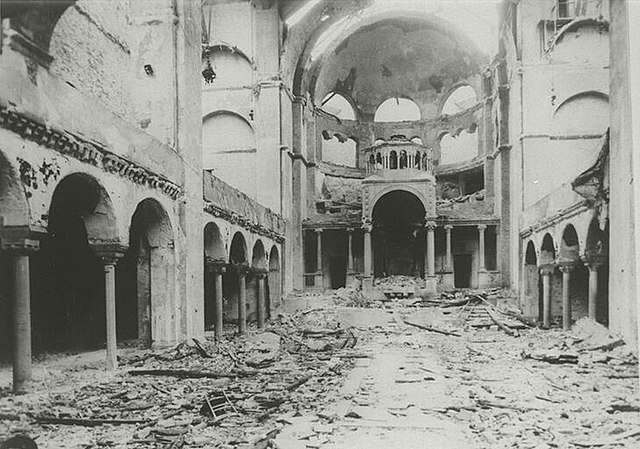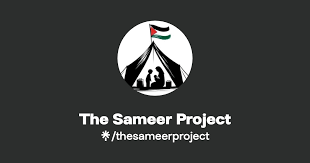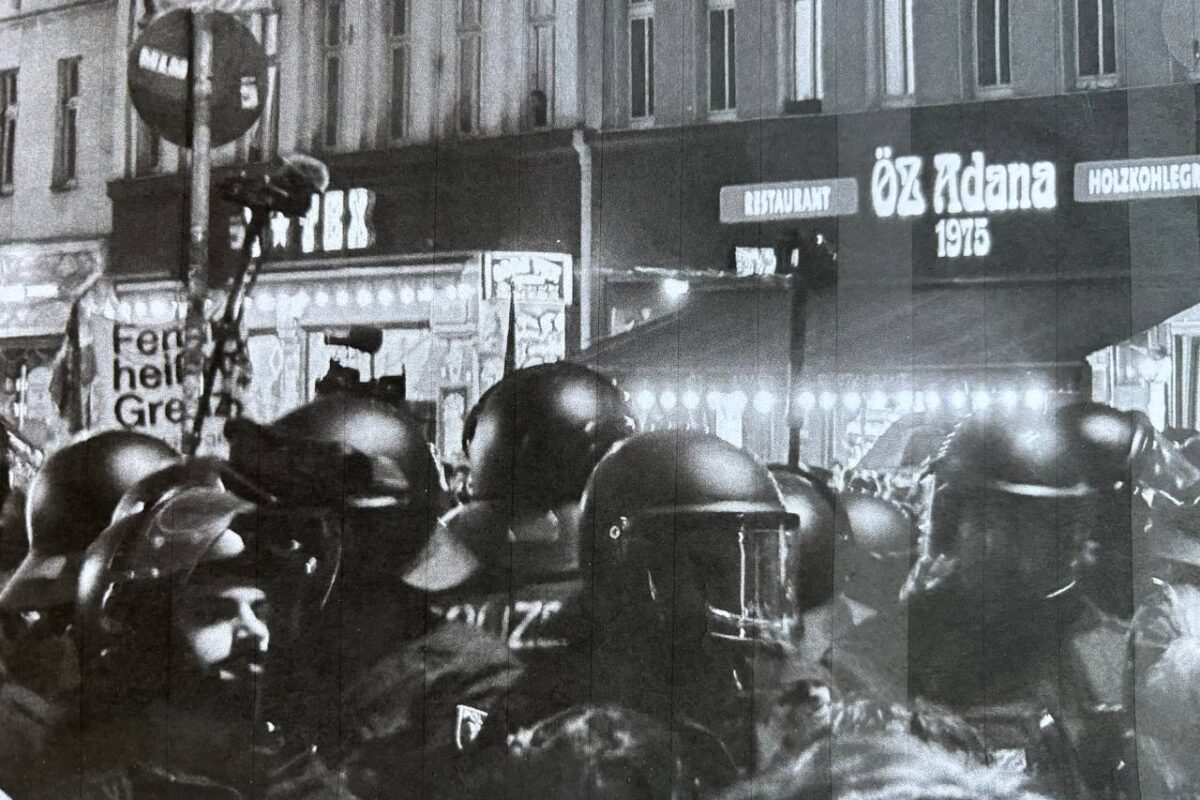November 9-10 is a time to remember the ‘Kristallnacht’. Literally meaning, “night of the broken glass”, Kristallnacht – also known as the “November pogrom” – was a time of widespread violence towards the Jewish population of Germany, committed primarily on 9–10 November 1938. This marked a turning point in the persecution of the Jews in Germany and was a paving stone in the horrific path which ultimately led to the concentration camps and gas chambers. The violence was planned and initiated centrally by the Nazi party, but was carried out at local levels by members of armed wing of the Nazis (the SA and the SS), giving it an appearance of mass anger against the Jewish population.
The Kristallnacht was marked by the widespread destruction of Jewish property and places of worship. More than 1400 synagogues throughout Germany were destroyed, together with 7500 Jewish homes and businesses, community centres and even cemeteries. The broken glass from the destroyed properties gave rise to the name “Kristallnacht”, which is actually a euphemism for the widespread destruction of Jewish lives and livelihoods. More than 400 people were murdered or driven to suicide and in the following days the German security police, the Gestapo, arrested around 30,000 Jewish men, who were sent to concentration camps where many were murdered or died. Kristallnacht was a terrible sign of the horrors of the holocaust to come. While the Kristallnacht is remembered by the world, what is not so well remembered are the events leading up to Kristallnacht used by the Nazis as a pretext for unleashing such violence on the Jews of Germany.
The persecution of the Jews had been increasing in intensity ever since Hitler came to power in 1933 through a series of anti-Jewish laws restricting the rights of German Jews to means of livelihood and dignified lives. This persecution was heightened by the first mass deportation of Jews from Germany in the so-called “Polenaktion” (Polish action) in which more than 17,000 Polish Jews were expelled from Germany on 28 October 1938. They were ordered to leave their homes in a single night and were allowed only one suitcase per person to carry their belongings. They were put on trains to the Polish border where the Polish border police pushed them back into Germany. This continued for days in the November cold and rain, with the persecuted remaining without food and shelter between the two borders. A British newspaper wrote that hundreds “are reported to be lying about, penniless and deserted, in little villages along the frontier near where they had been driven out by the Gestapo and left.” A British woman, who had gone to help the expelled people, recalled that conditions in the refugee camps “Were so bad that some actually tried to escape back into Germany and were shot.”
Among these expelled Jewish families was the Grynszpan family. The family had emigrated from Poland in 1911 and had been living in Hannover ever since. On 3rd November 1938, their 17 year old son, Herschel Grynszpan, who was living in Paris with his uncle, received a postcard from the family describing the dire situation on the German-Polish border. They asked him for any help he could provide. On 7th November 1938, Herschel went to the German embassy in Paris with a revolver and fired five bullets at Ernst vom Rath, a German diplomat. Herschel made no attempt to escape and freely confessed to the shooting. He carried a postcard in his pocket with the message to his parents, “May God forgive me … I must protest so that the whole world hears my protest, and that I will do.”
Vom Rath died of his injuries on 9th November, 1938. This assassination provided the pretext for the Nazis to attack the Jewish population with unprecedented ferocity during Kristallnacht. Nazi propaganda portrayed the violence against the Jews of Germany as an outbreak of “spontaneous national rage” sparked by the “cowardly murder” in Paris. For the Nazis, this individual act of “terrorism” was the excuse to inflict collective punishment on the Jews of Germany. What happened subsequently is history, a history that should never be repeated.
The memory of Kristallnacht, therefore, acquires further poignancy at this time of collective punishment of the Palestinian population by Israel, using the “terrorism” of Hamas as pretext. Following Hamas’ attack on Israeli civilians and soldiers on 7th October, 2023 (killing 1200 people and taking 200 Israelis hostage) the relentless bombing of Gaza by the Israeli Defence Forces has killed more than 10´5,000 people and nearly completely destroyed Gaza. Houses, mosques, hospitals and refugee camps have been indiscriminately bombed and destroyed. Food, water, fuel and electricity have been cut off and Gazans from the North of the strip have been forced from their homes. Hundreds of thousands are now concentrated in the south, desperately trying to escape the death and destruction.
The concept of collective punishment is abhorrent, whoever be its victims and perpetrators. It is also illegal; a war crime prohibited in both international and non-international armed conflicts by Article 33 of the Fourth Geneva Convention and Article 6 of the Additional Protocol II. Article 33 states “No protected person may be punished for an offence he or she has not personally committed. Collective penalties and likewise all measures of intimidation or of terrorism are prohibited.” Moreover, Article 13 of the Additional Protocol II states that “The civilian population as such, as well as individual civilians, shall not be the object of attack. Acts or threats of violence the primary purpose of which is to spread terror among the civilian population are prohibited.” The prohibition against collective punishment was specifically incorporated in the Geneva Convention of 1949 because of the Nazis’ prolific use against Jews and other populations in Germany and the German-occupied territories. These include the village of Lidice in Czechoslovakia, in Oradour-sur-Glane in France, in Putten in the Netherlands, in Sant’Anna di Stazzema and Marzabotto in Italy, in Kortelisy in Soviet Ukraine and in Pirčiupia in Lithuania (where 119 people, including 49 children under 16, were burned alive by a German punishment squadron following an attack of Soviet partisans in a nearby forest).
It is, therefore, ironic that the Jewish state of Israel, the state formed by and for the original victims of collective punishment, is today using it against the Palestinian population of Gaza, with most world governments remaining silent and simultaneously stating it as a right of the Israeli government to “self defence”. The pretext of self defence in the face of apparent acts of individual “terrorism”, disregarding the contexts producing such acts, has long been used by repressive states when inflicting collective punishment on populations. The description of the Palestinians as “human animals” by the Israeli defence minister Yoav Gallant is eerily reminiscent of the Nazi characterization of Jews as “sub-humans”. In the so called “war against terror,” over the last two decades, collective punishment has often been normalized as “collateral damage.” We see this playing out in Gaza too. However, it would be an utter disrespect to the memories of the victims of Kristallnacht, and of the many other instances of collective punishment by the Nazis, not to recognize what is happening today in Gaza as the collective punishment of the Palestinians and to demand an immediate stop to it.



